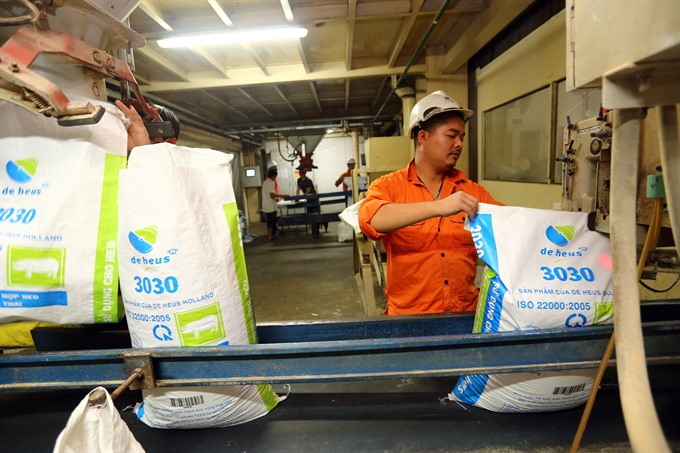 Economy
Economy

The animal feed industry of Việt Nam, despite being among the world’s fastest-growing by scale and output, is dominated by foreign firms while local producers are struggling to compete.
 |
| Animal feed packed at Netherlands - invested DE HEUS in Vĩnh Phúc Province’s Bình Xuyên Industrial Zone. Many foreign-invested animal feed producers recently expanded production in Việt Nam. — VNA/VNS Photo Danh Lam |
HÀ NỘI — The animal feed industry of Việt Nam, despite being among the world’s fastest-growing by scale and output, is dominated by foreign firms while local producers are struggling to compete.
According to Nguyễn Xuân Dương, deputy director of the Ministry of Agriculture and Rural Development’s Department of Livestock Production, the animal feed industry maintained two-digit growth in the past two decades, with the output jumping from 400,000 tonnes in 1993 to more than 23 million tonnes in 2016.
Việt Nam is today the leading country in ASEAN and the 10th in the world in animal feed production.
However, the rapid expansion of foreign producers in Việt Nam is posing threat to local firms.
Recently, Korea’s CJ Group opened its fifth animal feed plant in Việt Nam and is planning to open the sixth one this year.
A US$15-million plant with an annual output of 500,000 tonnes in the northern province of Hải Dương was recently opened by Singapore’s HAID, which has invested in six plants throughout the country already.
Indonesia’s Java Pelletising Factory also invested VNĐ135 billion ($5.97 million) in building a plant with a monthly capacity of 15,000 tonnes in Bình Định Province - its fifth plant in Việt Nam.
Thailand’s CP Group owns four animal feed plants in Việt Nam, with an annual capacity of more than 400,000 tonnes each. Uni-President from Taiwan, besides owning three plants producing fish feed of 300,000 tonnes annually, has invested $20 million to build another 100,000-tonne capacity plant in Quảng Nam Province.
Hoàng Hương Giang from the ministry’s Animal Husbandry Department said there were 218 animal feed plants in Việt Nam, with an average monthly capacity of 28,200 tonnes. Of these, 71 are foreign firms, with an average monthly capacity of more than 15,700 tonnes and hold a market share of some 65 per cent.
Lê Bá Lịch, chairman of the Animal Husbandry Association of Việt Nam, said local animal feed producers outnumbered foreign producers but held a market share of just some 30 per cent.
Lịch said the market share of local producers was in danger of narrowing down even as local producers were expanding. “It is important to adjust strategies to compete,” he said.
Many local producers are striving to cut costs and lower prices by selling directly to farmers instead of going through agents, but some have not been able to avoid losses.
Lịch said foreign firms had stronger financial capacity, experience, modern production line and especially appropriate distribution strategies to expand their market.
According to Hoàng Thanh Vân, director of the Animal Husbandry Department, animal feed production requires high technology and huge investment, in which local producers are often weaker than FDI companies.
Đoàn Viết Cường, general director of Adeco, said domestic producers must promote the export of animal feed as production capacity exceeds the local demand. — VNS




